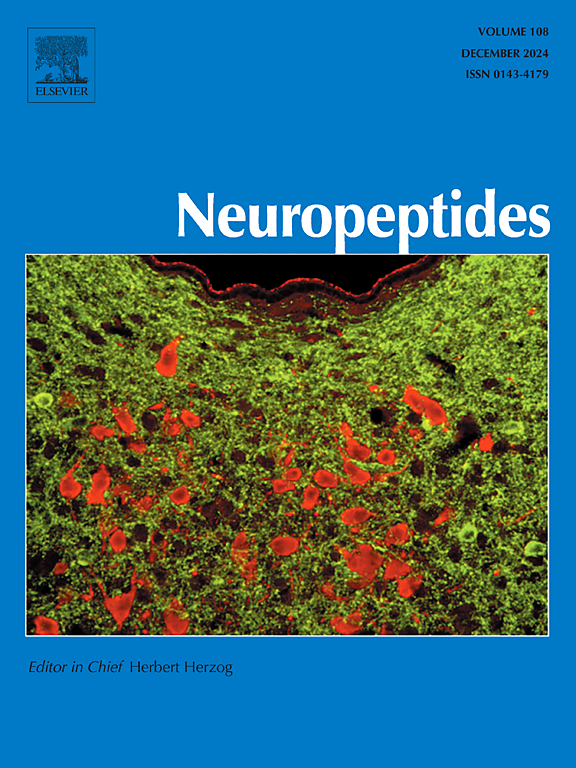Transcranial pulsed current stimulation alleviates neuronal pyroptosis and neurological dysfunction following traumatic brain injury via the orexin-A/NLRP3 pathway
IF 2.7
3区 医学
Q3 ENDOCRINOLOGY & METABOLISM
引用次数: 0
Abstract
Traumatic brain injury (TBI) is a life-threatening condition with high incidence and mortality rates. The current pharmacological interventions for TBI exhibit limited efficacy, underscoring the necessity to explore novel and effective therapeutic approaches to ameliorate its impact. Previous studies have indicated that transcranial pulsed current stimulation (tPCS) can improve neurofunctional deficits in patients by modulating brain neuroplasticity. However, the exact mechanism underlying this neuroprotective effect remains elusive. In this study, mice with TBI induced by controlled cortical impact were subjected to 30 min of daily tPCS for 5 consecutive days and intraperitoneally administered an orexin receptor type 1 (OX1R) antagonist (SB334867). The neuroprotective effects of tPCS and its potential mechanisms were assessed through behavioral tests, histopathological examination, immunohistochemistry and Western blotting. In vitro experiments involved stimulating HT22 cells with LPS + ATP to assess the anti-neuroinflammatory effects of Orexin-A (OX-A) using CCK-8, Western blotting, and Flow cytometry. The results demonstrated that tPCS reduced the mNSS in TBI mice, ameliorated tissue damage, improved motor and cognitive deficits, and upregulated OX-A expression. Notably, SB334867 reversed the protective effects of tPCS. In vitro studies revealed that OX-A inhibited the formation and activation of NLRP3 inflammasomes, resulting in reduced levels of ROS and restoration of MMP. However, this effect could be reversed by the NLRP3 agonist BMS-986299. Our findings suggest that tPCS promotes the release of OX-A and modulates the OX1R/NLRP3 pathway to mitigate the inflammatory response following TBI, thereby exerting neuroprotective effects.

经颅脉冲电流刺激可通过orexin-A/NLRP3通路缓解外伤性脑损伤后神经元焦亡和神经功能障碍
外伤性脑损伤(TBI)是一种发病率高、死亡率高、危及生命的疾病。目前对创伤性脑损伤的药物干预显示出有限的疗效,这强调了探索新的有效治疗方法来改善其影响的必要性。先前的研究表明,经颅脉冲电流刺激(tPCS)可以通过调节脑神经可塑性来改善患者的神经功能缺陷。然而,这种神经保护作用的确切机制仍然难以捉摸。在这项研究中,由控制性皮质冲击诱导的TBI小鼠连续5天每天接受30分钟的tPCS,并腹腔注射食欲素受体1型(OX1R)拮抗剂(SB334867)。通过行为学试验、组织病理学检查、免疫组织化学和免疫印迹法评价tPCS的神经保护作用及其可能机制。体外实验采用CCK-8、Western blotting和流式细胞术,用LPS + ATP刺激HT22细胞,评估Orexin-A (OX-A)的抗神经炎作用。结果表明,tPCS可降低TBI小鼠的mNSS,改善组织损伤,改善运动和认知缺陷,上调OX-A表达。值得注意的是,SB334867逆转了tPCS的保护作用。体外研究表明,OX-A抑制NLRP3炎性小体的形成和激活,导致ROS水平降低,MMP恢复。然而,这种作用可以被NLRP3激动剂BMS-986299逆转。我们的研究结果表明,tPCS促进OX-A的释放并调节OX1R/NLRP3通路,从而减轻TBI后的炎症反应,从而发挥神经保护作用。
本文章由计算机程序翻译,如有差异,请以英文原文为准。
求助全文
约1分钟内获得全文
求助全文
来源期刊

Neuropeptides
医学-内分泌学与代谢
CiteScore
5.40
自引率
6.90%
发文量
55
审稿时长
>12 weeks
期刊介绍:
The aim of Neuropeptides is the rapid publication of original research and review articles, dealing with the structure, distribution, actions and functions of peptides in the central and peripheral nervous systems. The explosion of research activity in this field has led to the identification of numerous naturally occurring endogenous peptides which act as neurotransmitters, neuromodulators, or trophic factors, to mediate nervous system functions. Increasing numbers of non-peptide ligands of neuropeptide receptors have been developed, which act as agonists or antagonists in peptidergic systems.
The journal provides a unique opportunity of integrating the many disciplines involved in all neuropeptide research. The journal publishes articles on all aspects of the neuropeptide field, with particular emphasis on gene regulation of peptide expression, peptide receptor subtypes, transgenic and knockout mice with mutations in genes for neuropeptides and peptide receptors, neuroanatomy, physiology, behaviour, neurotrophic factors, preclinical drug evaluation, clinical studies, and clinical trials.
文献相关原料
公司名称
产品信息
索莱宝
0.2 % thionin solution
 求助内容:
求助内容: 应助结果提醒方式:
应助结果提醒方式:


